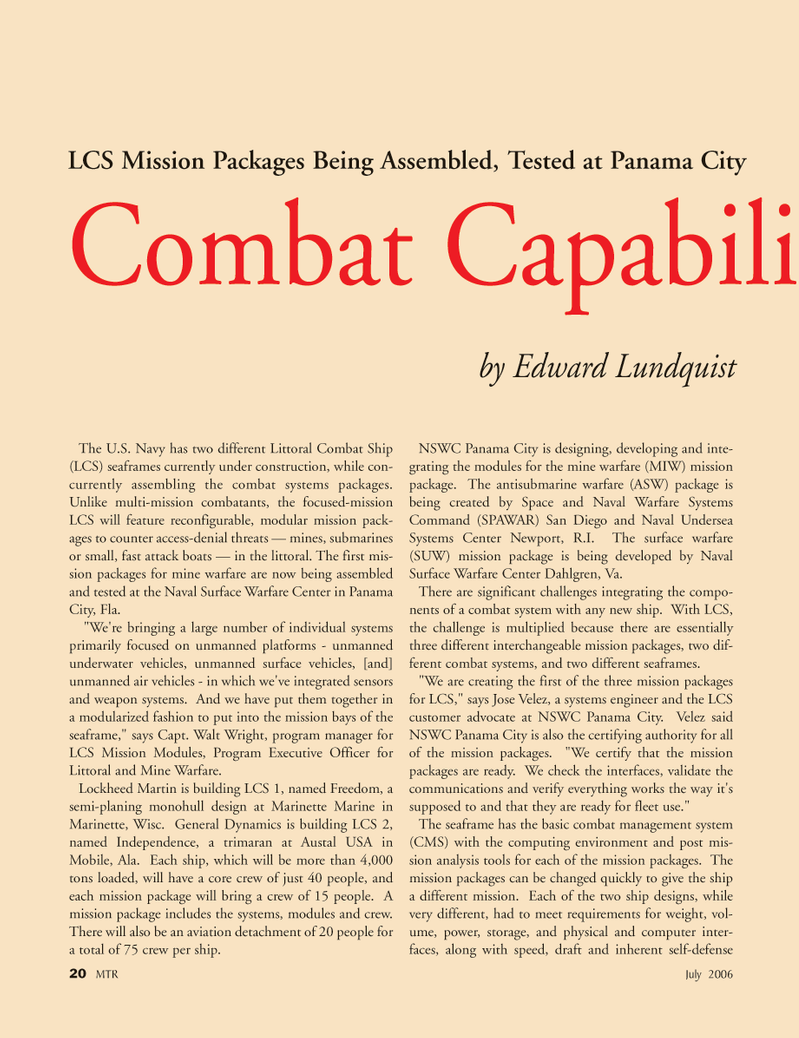
Page 20: of Marine Technology Magazine (July 2006)
Underwater Defense: Port & Harbor Security
Read this page in Pdf, Flash or Html5 edition of July 2006 Marine Technology Magazine
20 MTR July 2006
The U.S. Navy has two different Littoral Combat Ship (LCS) seaframes currently under construction, while con- currently assembling the combat systems packages.
Unlike multi-mission combatants, the focused-mission
LCS will feature reconfigurable, modular mission pack- ages to counter access-denial threats — mines, submarines or small, fast attack boats — in the littoral. The first mis- sion packages for mine warfare are now being assembled and tested at the Naval Surface Warfare Center in Panama
City, Fla. "We're bringing a large number of individual systems primarily focused on unmanned platforms - unmanned underwater vehicles, unmanned surface vehicles, [and] unmanned air vehicles - in which we've integrated sensors and weapon systems. And we have put them together in a modularized fashion to put into the mission bays of the seaframe," says Capt. Walt Wright, program manager for
LCS Mission Modules, Program Executive Officer for
Littoral and Mine Warfare.
Lockheed Martin is building LCS 1, named Freedom, a semi-planing monohull design at Marinette Marine in
Marinette, Wisc. General Dynamics is building LCS 2, named Independence, a trimaran at Austal USA in
Mobile, Ala. Each ship, which will be more than 4,000 tons loaded, will have a core crew of just 40 people, and each mission package will bring a crew of 15 people. A mission package includes the systems, modules and crew.
There will also be an aviation detachment of 20 people for a total of 75 crew per ship.
NSWC Panama City is designing, developing and inte- grating the modules for the mine warfare (MIW) mission package. The antisubmarine warfare (ASW) package is being created by Space and Naval Warfare Systems
Command (SPAWAR) San Diego and Naval Undersea
Systems Center Newport, R.I. The surface warfare (SUW) mission package is being developed by Naval
Surface Warfare Center Dahlgren, Va.
There are significant challenges integrating the compo- nents of a combat system with any new ship. With LCS, the challenge is multiplied because there are essentially three different interchangeable mission packages, two dif- ferent combat systems, and two different seaframes. "We are creating the first of the three mission packages for LCS," says Jose Velez, a systems engineer and the LCS customer advocate at NSWC Panama City. Velez said
NSWC Panama City is also the certifying authority for all of the mission packages. "We certify that the mission packages are ready. We check the interfaces, validate the communications and verify everything works the way it's supposed to and that they are ready for fleet use."
The seaframe has the basic combat management system (CMS) with the computing environment and post mis- sion analysis tools for each of the mission packages. The mission packages can be changed quickly to give the ship a different mission. Each of the two ship designs, while very different, had to meet requirements for weight, vol- ume, power, storage, and physical and computer inter- faces, along with speed, draft and inherent self-defense
LCS Mission Packages Being Assembled, Tested at Panama City
Combat Capability by Edward Lundquist
MTR#6 (17-32).qxd 7/11/2006 8:47 AM Page 20

 19
19

 21
21
